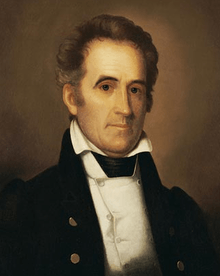1835 Democratic National Convention
|
1836 presidential election | |
  Nominees Van Buren and Johnson | |
| Convention | |
|---|---|
| Date(s) | May 20–22, 1835 |
| City | Baltimore, Maryland |
| Venue | Fourth Presbyterian Church |
| Candidates | |
| Presidential nominee | Martin Van Buren of New York |
| Vice Presidential nominee | Richard M. Johnson of Kentucky |
The 1835 Democratic National Convention was a presidential nominating convention that was held from May 20 to May 22, 1835, in Baltimore, Maryland. This was the second national convention of the Democratic Party of the United States. The delegates nominated Vice President Martin Van Buren for President and Representative Richard Mentor Johnson of Kentucky for Vice President.
Background
On February 23, 1835, President Andrew Jackson wrote to James Gwin of Tennessee and claimed a preference for someone who would "most likely to be the choice of the great body of republicans" in regard to his successor. He expressed the desire to hold another national convention to nominate candidates for the presidency and vice presidency. He instructed Gwin to show the letter to the editor of the Nashville Republican. The newspaper later reprinted the letter.[1]
Proceedings
Andrew Stevenson of Virginia served as the chairman and convention president. Six convention vice presidents and four secretaries were appointed.
Tennessee, Illinois, South Carolina, and Alabama sent no delegates to the convention.
Presidential nomination
Presidential candidates
President Jackson had long planned for Vice President Martin Van Buren to succeed him, and Van Buren was the unanimous choice of the delegates for the presidency.
Vice Presidential nomination
Vice Presidential candidates


Former Senator
William C. Rives
of Virginia
Jackson and other major Democrats had settled on Richard Mentor Johnson, a Kentucky congressman who had fought in the War of 1812, as Van Buren's running mate. Many Virginia Democrats instead backed William Cabell Rives, the former Ambassador to France, but Johnson narrowly won the required 2/3 of the vote on the first vice presidential ballot.[2]
A man from Tennessee, Edward Rucker, who was present at the convention but not sent as a delegate, cast all 15 votes Tennessee was entitled to for Van Buren and for Johnson for the contested vice presidential nomination. Johnson was nominated for the vice presidency after he narrowly won more than two-thirds of the total delegates' votes. The delegation of Virginia declared that it had no confidence in Johnson's character and principles, and would not support him.[3]
| Name | Home State | Delegate Vote | Percentage |
|---|---|---|---|
| Richard Mentor Johnson | Kentucky | 178 | 67% |
| William Cabell Rives | Virginia | 87 | 33% |

1st Vice Presidential Ballot
Letters went out on May 23 from the convention president and vice presidents asking for the acceptance of the nominations by the nominees. Van Buren replied and accepted the nomination on May 29;[4] Johnson, likewise on June 9.[5]
General Election
The Whigs did not put forward a national ticket nominated by national convention. Van Buren defeated his many competitors for the presidency in the general election. While the electors of Virginia supported Van Buren for the presidency, they cast their vice presidential votes for William Smith. Consequently, Johnson received a plurality, but not a majority, of the electoral votes for the vice presidency. In the subsequent contingent election in the Senate, Johnson was elected vice president.
See also
Notes
- ↑ Niles, Hezekiah, ed. (April 4, 1835), "Gen. Jackson's Letter", Niles' Weekly Register, H. Niles, 48, pp. 80–81
- ↑ Witcover, Jules (2014). The American Vice Presidency. Smithsonian Books. pp. 90–91.
- ↑ Irelan, John Robert (1887). "History of the Life, Administration and Times of Martin Van Buren, Eighth President of the United States". Chicago: Fairbanks and Palmer Publishing Company. p. 233. Retrieved March 6, 2017.
- ↑ Niles, Hezekiah, ed. (June 13, 1835), "Mr. Van Buren's Acceptance", Niles' Weekly Register, H. Niles, 48, pp. 257–258
- ↑ Niles, Hezekiah, ed. (July 11, 1835), "Col. Johnson's Acceptance", Niles' Weekly Register, H. Niles, 48, pp. 329–330
References
- Proceedings of the convention, Niles' Weekly Register, Volume XLVIII, March 1835 to September 1835
| Preceded by 1832 Baltimore, Maryland |
Democratic National Conventions | Succeeded by 1840 Baltimore, Maryland |